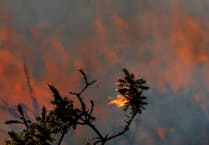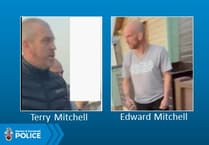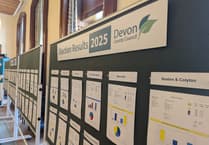THE January meeting of Thorverton History Society started with the AGM.
We are now down to 41 members and new members or visitors are always welcome and a list of talks is now in the February edition of "Focus".
With the AGM out of the way Dr Richard Cringle was able to deliver his talk entitled "Forgotten Delights" with the aid of power point and an old magic lantern slide show.
He is with the English department at Exeter University but his interest in old photographic slides started after he attended and exhibition entitles “Life through the lens” in 2013 at the Royal Albert Memorial Museum (RAMM).
The museum has a collection of more than 4,700 glass slides and he volunteered to photograph and catalogue the collection.
The old glass slides are 3.25 x 3.25 inches square and were projected onto a screen from a magic lantern. Originally the lanterns used oil lamps for the light source so the projected image was poor. Projection was improved with electric light bulbs but these were very hot.
The photographic process for producing slides was the same as that used for producing photographic prints – instead of exposing the negative onto photographic paper is was exposed to a glass slide which had a photo sensitive coating. A protective piece of glass was then mounted onto the image.
Slide shows were very popular and slides were produced commercially for showing.
The beauty of a slide show was that it could be presented to an audience with an element of showmanship. The RAMM produced some of their own but others were donated or bequeathed by local enthusiasts. One local was Alfred Rowden who provided 1,200 slides.
He started his working life in a dairy and rose to become it’s managing director. He was a very keen photographer and during WW1 he was based in Basra and Baghdad where he took many photographs. Another benefactor gave more than 700.
Mr F W Rowley was the curator of the RAMM from 1902 until 1932 and he was a driving force behind increasing interest and activity at the museum.
In cataloguing the slides they have been divided in subjects. These are Natural History, Historic Exeter, Local Views, Human Physiology, Agriculture and personal collections.
Human physiology slides were produced by a local doctor and possibly used as a teaching resource.
There was a big use of slides as temperance propaganda and there is a lot of religious material in the collection as well as art work.
There are a lot of images of local Devon views. Country lanes, harbours, Clovelly, Okehampton, Exeter Cathedral Close, Exeter high street, and Bickleigh and the Exe Valley all feature in the collection.
Work is ongoing to try to identify the different photographers who captured the images.
Another prolific photographer was William Weaver Baker, a chemist who worked in Exeter. His wife was also a photographer and about 600 of his slides are in the collection. Some are very odd like his doll series. Many are of cats but there are many farming views, seaside views, trains and North Devon.
Richard showed a collection of glass slides taken from the cathedral on a sunny day in the 1920’s with people appearing to be making their way to the Royal Clarence Hotel.
Others slides were aerial photo’s from the 1930’s and included the Cathedral and the now demolished Mary Major church which was at the west end of the Cathedral Close.
Others were post World War Two images taken from the Cathedral north tower and showed Bedford Circus and the ABC cinema after the Blitz of 1942.
Robert TurnerTHE January meeting of Thorverton History Society started with the AGM.
We are now down to 41 members and new members or visitors are always welcome and a list of talks is now in the February edition of "Focus".
With the AGM out of the way Dr Richard Cringle was able to deliver his talk entitled "Forgotten Delights" with the aid of power point and an old magic lantern slide show.
He is with the English department at Exeter University but his interest in old photographic slides started after he attended and exhibition entitles “Life through the lens” in 2013 at the Royal Albert Memorial Museum (RAMM).
The museum has a collection of more than 4,700 glass slides and he volunteered to photograph and catalogue the collection.
The old glass slides are 3.25 x 3.25 inches square and were projected onto a screen from a magic lantern. Originally the lanterns used oil lamps for the light source so the projected image was poor. Projection was improved with electric light bulbs but these were very hot.
The photographic process for producing slides was the same as that used for producing photographic prints – instead of exposing the negative onto photographic paper is was exposed to a glass slide which had a photo sensitive coating. A protective piece of glass was then mounted onto the image.
Slide shows were very popular and slides were produced commercially for showing.
The beauty of a slide show was that it could be presented to an audience with an element of showmanship. The RAMM produced some of their own but others were donated or bequeathed by local enthusiasts. One local was Alfred Rowden who provided 1,200 slides.
He started his working life in a dairy and rose to become it’s managing director. He was a very keen photographer and during WW1 he was based in Basra and Baghdad where he took many photographs. Another benefactor gave more than 700.
Mr F W Rowley was the curator of the RAMM from 1902 until 1932 and he was a driving force behind increasing interest and activity at the museum.
In cataloguing the slides they have been divided in subjects. These are Natural History, Historic Exeter, Local Views, Human Physiology, Agriculture and personal collections.
Human physiology slides were produced by a local doctor and possibly used as a teaching resource.
There was a big use of slides as temperance propaganda and there is a lot of religious material in the collection as well as art work.
There are a lot of images of local Devon views. Country lanes, harbours, Clovelly, Okehampton, Exeter Cathedral Close, Exeter high street, and Bickleigh and the Exe Valley all feature in the collection.
Work is ongoing to try to identify the different photographers who captured the images.
Another prolific photographer was William Weaver Baker, a chemist who worked in Exeter. His wife was also a photographer and about 600 of his slides are in the collection. Some are very odd like his doll series. Many are of cats but there are many farming views, seaside views, trains and North Devon.
Richard showed a collection of glass slides taken from the cathedral on a sunny day in the 1920’s with people appearing to be making their way to the Royal Clarence Hotel.
Others slides were aerial photo’s from the 1930’s and included the Cathedral and the now demolished Mary Major church which was at the west end of the Cathedral Close.
Others were post World War Two images taken from the Cathedral north tower and showed Bedford Circus and the ABC cinema after the Blitz of 1942.
Robert Turner
.jpg?width=209&height=140&crop=209:145,smart&quality=75)



Comments
This article has no comments yet. Be the first to leave a comment.